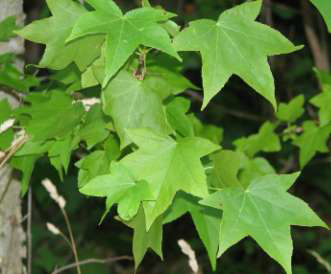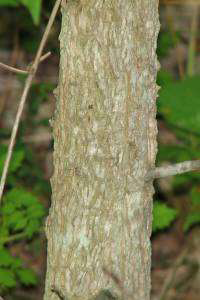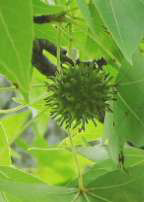 Sweet Gum
Sweet Gum
(Liquidambar styraciflua L.)
|
Classification |
| Kingdom: |
Plantae |
| Division: |
Magnoliophyta |
| Class: |
Magnoliopsida |
| Order: |
Saxifragales |
| Family: |
Altingiaceae |
| Genus: |
Liquidambar |
| Species: |
L. styraciflua |
 Characteristics: Sweet Gum is a large, aromatic tree with a straight trunk and gray, deeply furrowed, scaly bark. The tree can grow to heights ranging from 60 to 100 feet. The leaves are 3 to 6 inches long and wide. They are star shaped and have 5, or sometimes 7, deep, finely toothed lobes. In the spring, greenish ball-like clusters of flowers form with the male flowers in clusters along the stalk and the female flowers in drooping clusters on the same tree. The sweet gum is probably most easily recognized by its fruit. Approximately 1 inch in diameter, the long-stalked drooping brown ball is actually composed of many individual fruits, ending in 2 long curved prickly points. The seeds mature in the fall and persist through the winter.
Characteristics: Sweet Gum is a large, aromatic tree with a straight trunk and gray, deeply furrowed, scaly bark. The tree can grow to heights ranging from 60 to 100 feet. The leaves are 3 to 6 inches long and wide. They are star shaped and have 5, or sometimes 7, deep, finely toothed lobes. In the spring, greenish ball-like clusters of flowers form with the male flowers in clusters along the stalk and the female flowers in drooping clusters on the same tree. The sweet gum is probably most easily recognized by its fruit. Approximately 1 inch in diameter, the long-stalked drooping brown ball is actually composed of many individual fruits, ending in 2 long curved prickly points. The seeds mature in the fall and persist through the winter.
Habitat: Sweet gum grows well in the moist soils of valleys and lower slopes and mixed woodlands. It is a pioneer species invading clearings and old fields.
Range: It can be found from extreme southwest Connecticut to central Florida, and east Texas to southern Illinois. There are also some varieties found in eastern Mexico.
 Native American Uses: The Cherokee Indians used the inner bark for diarrhea, flux, and dysentery. They also used it as a slave for wounds, sores, and ulcers. An infusion of the bark was given to calm the nerves. The Rappahannock Indians used the sweet gum similarly. However, they also used it to make a drink from the sap and the bark to treat distemper in dogs.
Native American Uses: The Cherokee Indians used the inner bark for diarrhea, flux, and dysentery. They also used it as a slave for wounds, sores, and ulcers. An infusion of the bark was given to calm the nerves. The Rappahannock Indians used the sweet gum similarly. However, they also used it to make a drink from the sap and the bark to treat distemper in dogs.
Colonial Uses: The colonists obtained a “gum” by peeling back the bark and scraping off the resin-like solid. This gum was used medicinally, as well as in chewing gum.
Modern Uses: Today sweet gum is one of the leading furniture woods; it is used in the production of cabinets,veneer, plywood, barrels and boxes.